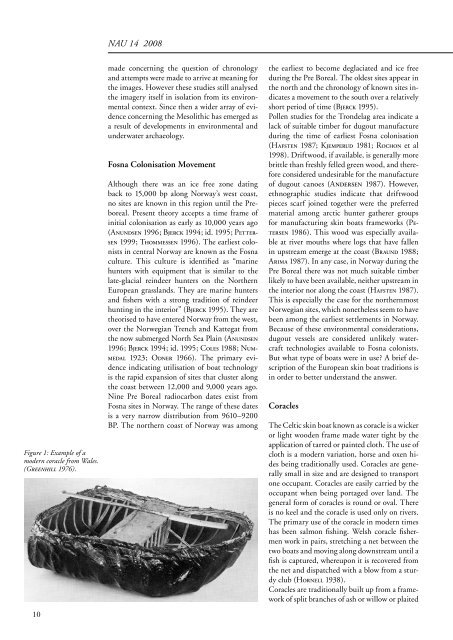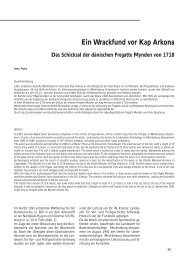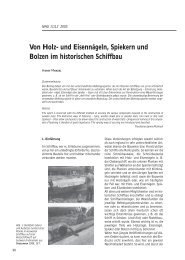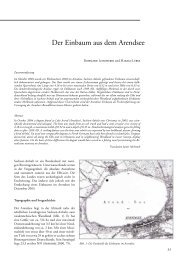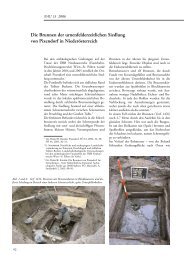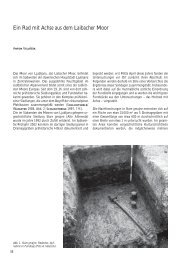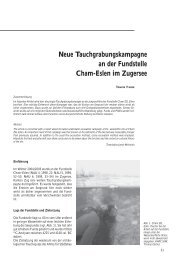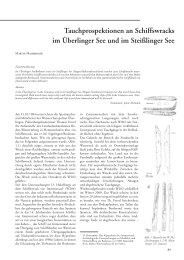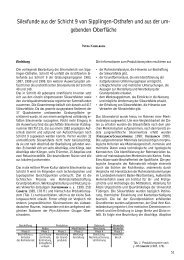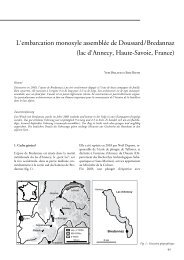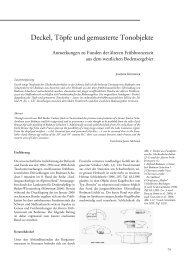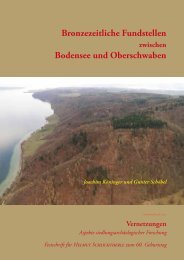Documents - Janus Verlag
Documents - Janus Verlag
Documents - Janus Verlag
Sie wollen auch ein ePaper? Erhöhen Sie die Reichweite Ihrer Titel.
YUMPU macht aus Druck-PDFs automatisch weboptimierte ePaper, die Google liebt.
NAU 14 2008Figure 1: Example of amodern coracle from Wales.(Greenhill 1976).10made concerning the question of chronologyand attempts were made to arrive at meaning forthe images. However these studies still analysedthe imagery itself in isolation from its environmentalcontext. Since then a wider array of evidenceconcerning the Mesolithic has emerged asa result of developments in environmental andunderwater archaeology.Fosna Colonisation MovementAlthough there was an ice free zone datingback to 15,000 bp along Norway’s west coast,no sites are known in this region until the Preboreal.Present theory accepts a time frame ofinitial colonisation as early as 10,000 years ago(Anundsen 1996; Bjerck 1994; id. 1995; Pettersen1999; Thommessen 1996). The earliest colonistsin central Norway are known as the Fosnaculture. This culture is identified as “marinehunters with equipment that is similar to thelate-glacial reindeer hunters on the NorthernEuropean grasslands. They are marine huntersand fishers with a strong tradition of reindeerhunting in the interior” (Bjerck 1995). They aretheorised to have entered Norway from the west,over the Norwegian Trench and Kattegat fromthe now submerged North Sea Plain (Anundsen1996; Bjerck 1994; id. 1995; Coles 1988; Nummedal1923; Odner 1966). The primary evidenceindicating utilisation of boat technologyis the rapid expansion of sites that cluster alongthe coast between 12,000 and 9,000 years ago.Nine Pre Boreal radiocarbon dates exist fromFosna sites in Norway. The range of these datesis a very narrow distribution from 9610–9200BP. The northern coast of Norway was amongthe earliest to become deglaciated and ice freeduring the Pre Boreal. The oldest sites appear inthe north and the chronology of known sites indicatesa movement to the south over a relativelyshort period of time (Bjerck 1995).Pollen studies for the Trondelag area indicate alack of suitable timber for dugout manufactureduring the time of earliest Fosna colonisation(Hafsten 1987; Kjemperud 1981; Rochon et al1998). Driftwood, if available, is generally morebrittle than freshly felled green wood, and thereforeconsidered undesirable for the manufactureof dugout canoes (Andersen 1987). However,ethnographic studies indicate that driftwoodpieces scarf joined together were the preferredmaterial among arctic hunter gatherer groupsfor manufacturing skin boats frameworks (Petersen1986). This wood was especially availableat river mouths where logs that have fallenin upstream emerge at the coast (Braund 1988;Arima 1987). In any case, in Norway during thePre Boreal there was not much suitable timberlikely to have been available, neither upstream inthe interior nor along the coast (Hafsten 1987).This is especially the case for the northernmostNorwegian sites, which nonetheless seem to havebeen among the earliest settlements in Norway.Because of these environmental considerations,dugout vessels are considered unlikely watercrafttechnologies available to Fosna colonists.But what type of boats were in use? A brief descriptionof the European skin boat traditions isin order to better understand the answer.CoraclesThe Celtic skin boat known as coracle is a wickeror light wooden frame made water tight by theapplication of tarred or painted cloth. The use ofcloth is a modern variation, horse and oxen hidesbeing traditionally used. Coracles are generallysmall in size and are designed to transportone occupant. Coracles are easily carried by theoccupant when being portaged over land. Thegeneral form of coracles is round or oval. Thereis no keel and the coracle is used only on rivers.The primary use of the coracle in modern timeshas been salmon fishing. Welsh coracle fishermenwork in pairs, stretching a net between thetwo boats and moving along downstream until afish is captured, whereupon it is recovered fromthe net and dispatched with a blow from a sturdyclub (Hornell 1938).Coracles are traditionally built up from a frameworkof split branches of ash or willow or plaited


